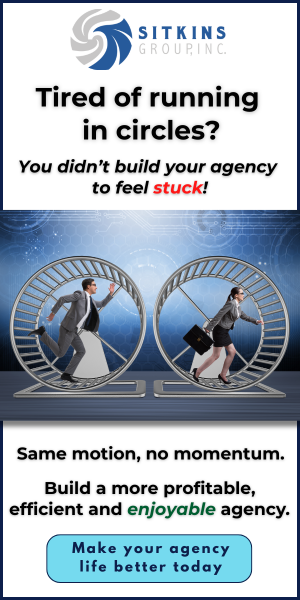Data intake solution automates
gathering quote information
By Christopher W. Cook
This writer has always had a problem with the synchronization between his brain and fingertips when typing, which leads to many backspaces and much rekeying. The number of times I’ve typed “being bullets” instead of “begin bullets” when leaving editorial marks on documents is astonishing. And as a frequent user of nods to pop culture in my articles, the amount of time spent correcting mistakes after minutes of online research to locate the appropriate reference is a buzzkill.
Data lives in your [prospect’s] head, your policies
and in the public domain … . SALT collects data from
all three sources and loads it into your rating software.
—Dustin Parker
Co-Founder
SALT
For insurance workers who have to key in lots of information, my “condition” (I probably just type too fast) would lead to problems. We’re talking about potential incorrect numbers, bad data and possible E&O exposures.
Fortunately, a tech firm has created a data intake platform that eliminates the need to enter and rekey information for insurance quote applications.
As an agency owner with over 18 years of experience, Dustin Parker, co-founder of SALT, recognized the tediousness of gathering information for personal lines quotes. “We don’t do personal lines anymore, but when we were, there was $300 to $500 of revenue on the table on a new opportunity,” he says.
“Watching our team go through 210 data points and spend an hour or two gathering data from different sources, including phone calls with the insured, and then loading it all into [our comparative rater], I just remember thinking ‘there’s got to be a better way to do this.’ It’s a horrible experience for the insured and the producer or the account manager.”
Parker teamed up with Jonathan Simmons, fellow SALT co-founder, who is a senior software engineer and product architect with over a decade of product development experience, to address the pain point in an agency’s workflow: the outdated, time-consuming, and error-prone process of collecting and transferring prospect data.
After prototypes were created in 2016 and then improved upon, SALT officially launched in 2019. As a data intake solution, SALT removes the need for the manual entering of prospect information by automating the process.
The product
I previously used the phrase “data intake solution,” but what does this mean?
“Data lives in your [prospect’s] head, your policies and in the public domain (e.g., your County Recorder’s [office] and BMV have a lot of information). SALT collects data from all three sources and loads it into your rating software,” Parker says.
“When someone puts their address into our application, we’re pulling all the data on the house, like the square footage and [if it has a] basement; everything that the public record has on the property, SALT pulls in.” This includes public data sources like Estated and Fenris, which can identify needed information on properties and vehicles.
To make comparisons in coverages and prices and identify coverage gaps, SALT also has the ability to securely pull declaration pages from carrier websites and generate a Policy Data Report.
“We have worked with MeasureOne and built an integration to pull all your policy data to the SALT platform [from your carrier sites],” Parker says. “If you’ve ever used Plaid to connect your financial institutions or to make a payment, it’s a similar experience.”
And after the data is entered once, it prefills across all necessary systems, including integrations with Applied EPIC, PL Rater, EZLynx and HawkSoft, among others.
While the intake process simplifies how agents collect data from prospective clients, equally important is the experience for the customer. “When you think about your brand, you think ‘what do I want this incoming customer to experience?’ The application oftentimes is the first experience they have, and most of us as consumers expect giving all that information to be a miserable experience,” Parker says. “SALT delivers a user experience in the agency’s brand, with their logo and in the way that they want to ask the questions.”
The platform is mobile friendly, with over 70% of its submissions completed on mobile devices. In the big picture, SALT isn’t just a tool; it helps build stronger client relationships from the first interaction.
Another benefit of the product is its ability to “power leverage referrals,” says Parker. “An agency in Tennessee [recently] reached out to us, and they’ve made a deal with a large Realtor® that has 2,000 real estate agents. SALT can issue a link to each of those agents, who can then refer their customers to the insurance agency with that link or a QR code. We’ll track exactly where it came from, and instead of getting a lead, the insurance agency is now getting a completed application [with the data pulled from public records].
“Our link system allows you to work with your commercial producers, local credit unions, mortgage brokers, real estate agents, and CPAs. Instead of saying ‘have them call us,’ they can hand them the link [to the application], which is customizable.
“It starts with a ‘squeeze page’ that [says something like] ‘Welcome to X Insurance. Thank you for coming from So-and-So Real Estate.’ [They’ll see] whatever message you want to give them to start the process, and then they can begin their application.”
The link also gives prospects the ability to submit needed information during an agency’s “after hours.” But for those agents and prospects who do want to have a conversation over the phone or in person, SALT has also enabled a Live Intake feature. As the agent enters the information, the platform validates the data in real time—delivering instant access to accurate, structured insights.
“You can key in the answers while you’re on the phone and still take advantage of the live, public data feed,” Parker says. “You’re not having to ask the prospect ‘what’s your VIN?’ or ‘Did you say M or N?’ ‘Was that D as in delta?’ That’s all gone with SALT. The conversation is faster, and you can get into a more advisory [role] and sell, which is what [producers] really want to be doing, not just asking about the numbers.”
SALT has great customer service, and they consistently
expand their integrations into other tech products
and improve options within their platform.
—Jessica Holder
Co-Founder
Eclipse Insurance Agency
Agency perspective
“The average agency will spend around 45 minutes to gather data for a home and auto quote and then key it into their rater; SALT takes that down to under five minutes. We conservatively say that we will save you 30 minutes per home and auto quote, or over 50 hours per 100 [quotes],” Parker says.
It’s no surprise that the saving of time on the quoting process has led to favorable responses from agency owners and their team members. (In the second quarter of 2025 alone, Parker says, 8,000 submissions were processed through SALT.)
Jessica Holder, co-founder of Eclipse Insurance Agency in Illinois, discovered SALT at the 2024 IndieTech Showcase in Indianapolis. “SALT has great customer service, and they consistently expand their integrations into other tech products and improve options within their platform,” she says.
“The forms are completely customizable,” she adds. “You can edit what the clients see, how many options they have, and you can also input suggestive selling into the text for those options. We have been able to create different forms for specific markets as well as multiple form links to track ROI on advertising.
“Sometimes options are unavailable on the form dropdowns that we regularly encounter,” Holder explains. “We have gotten around this by adding it into notes at the end of the agency facing intake form.”
According to Holder, SALT’s platform has increased Eclipse’s ROI by reducing the time spent on data entry. “Prospects have one way into our CRM—via SALT. It’s a streamlined process, assuring that we optimize the data we get from a prospect. It has also reduced clicks for our staff thanks to the rater integration.”
Team members at HAWK Advisers, an independent agency in Virginia, echo Holder’s comments. Personal Lines Advisor James Last was introduced to SALT by a co-worker as a “quick and intuitive way to capture information from prospective clients,” he says. “[SALT] seems committed to constantly improving their product.
“A major pro is the data prefill integrations they’ve added to the service,” Last explains. “It’s helped us stay competitive in a 21st-century market dominated by tech.
“Big names like Progressive, Travelers, and State Farm have huge budgets for apps and technology. As a local independent agency, we don’t have that kind of budget—but SALT has given us a grade-A tool that helps us stay relevant and efficient, even as a small agency.”
Fellow Personal Lines Adviser Stacey Cash, CPIA, agrees. “I would highly recommend using SALT, as it saves on having to make several phone calls or several emails being sent to obtain the information needed to get proposals completed,” she says.
“It makes things so much easier to get all the information needed. We can even go back and update information from a year ago to ‘carrier shop’ for a customer that may have experienced a rate increase, and then produce new proposals for our clients.”
Getting started
For agencies interested, SALT provides a white-glove onboarding process tailored to the agency’s structure and needs.
“We’ve learned that onboarding is everything. If we don’t onboard well, their employees aren’t going to use it,” Parker says. “We get the agency owner on board and have an onboarding administrative call to get everything set up. Then we also offer a call [via Zoom] with their team to show them best practices.”
An alternative onboarding experience is available for more “tech-oriented” leaders who may want to take a DIY approach. “[For them], we provide a kit with embedded videos, but most agencies want to have a meeting; we have an onboarding specialist on staff,” Parker adds.
“As we transition over to customer support, we’ve built a robust in-application support system. We really encourage our customers to use our ticket request or help center inside the app because we can track it and respond. It’s rare if we don’t get back the same business day; it’s typically in minutes.”
Additional agency support includes detailed reporting tools to track user performance, submission completion, and ROI metrics; access to in-app live chat; agency success resources, including webinars, feature updates and training, and agency data intake workflow; and a dedicated account manager (for larger agencies in the enterprise tier).
To request a demo or schedule a discovery call, contact Sales Director Jen Lyttle at jennie@saltinsure.com.
For more information:
SALT
saltinsure.com






